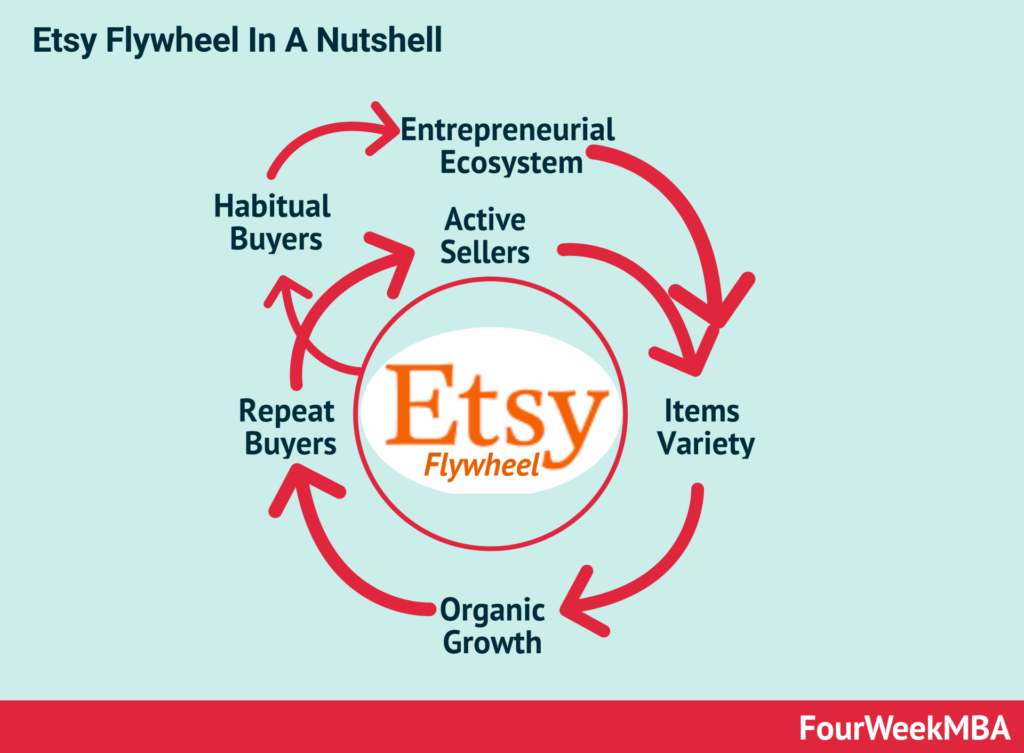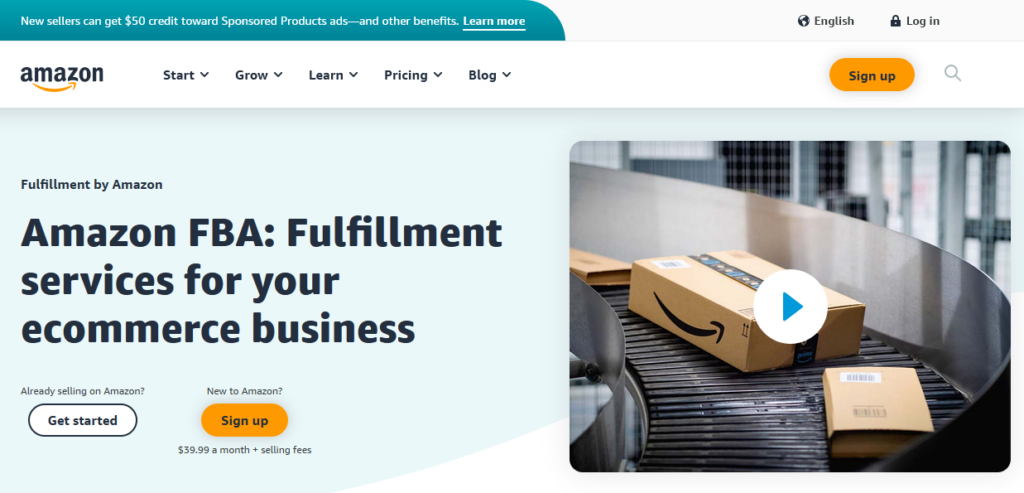What is the Amazon Flywheel? And how does it work?
Imagine having a business that not only sustains itself but grows over time.
All you have to do is focus on strategy and innovation.
This is what makes the Amazon flywheel so appealing.
And in this post, we’ll explore:
- How the Amazon flywheel works
- Where it originated
- Successful businesses that use it
- How to replicate it yourself
- And much more
Let’s dive in.
The Amazon Flywheel in a Nutshell
The Amazon flywheel is a customer-centric and self-sustained business model. It was popularized by Amazon’s founder and former CEO, Jeff Bezos.
It works like this:
- The wide “Selection” of products fulfills “Customer experience”.
- A positive customer experience generates more “Traffic”
- More traffic leads to more third-party “Sellers”
- More sellers lead to a wider selection, closing the circuit
- The business then has a “Lower Cost Structure”
- Lower operating costs mean “Lower Prices” of products
It’s like an internal feedback loop, focused on improving customer experience.
Here’s a short video that covers the basics well:
Amazon Flywheel Success: What Makes it So Effective?
Instead of a linear sales approach like a single sales funnel, the Amazon flywheel strategy is cyclical.
The business still has sales funnels within it, but the flywheel paints a bigger picture. This highlights the parts that contribute to customer satisfaction.
Having a large selection of products is key because it attracts a lot of customers. Bezos fulfilled this in the early days of Amazon, choosing books as “the first best product to sell online.”
Books are also small and easy to ship, making it easy for the company to focus on having a good customer experience, which drives more traffic.
This rise in traffic appeals to more third-party sellers, choosing Amazon as the platform to sell their products.
Eventually, this led Amazon to branch into a wider range of products, attracting even more sellers to the platform. With more sellers, it brings us back to having a larger selection of products.
With more resources, the company can invest heavily in efficiency, which lowers the cost of structure.
This is vital because it means the more customers, sellers, and range of products, the more efficient the business gets, which is unheard of in other business models.
Amazon doesn’t stop there:
- Amazon Prime,
- Kindle books,
- Amazon web services,
- and Audible are also available.
All extensions of the Amazon flywheel.
“To have a flywheel, only one thing has to be true: For every one customer, the experience must get better.” – Sam Ovens
Companies that focus on competition and comparison fall into the “Doom Loop”, being reactive to past failures and so taking a new direction. This prevents them from gaining momentum and leads to disappointing results.
The Amazon Flywheel Origin Story
Originally coined the Amazon virtuous cycle, it came from an adaptation of the flywheel concept from the book Good to Great by Jim Collins.
He later expands on the concept in his accompanying book “Turning the Flywheel,” published in 2019.
The book starts with the story of how Bezos took the flywheel concept to another level. He defined the components of what drives the company to build unstoppable momentum.
It was Bezos’ meeting with Collins in 2000 and his understanding of the flywheel that helped the company see profit for the first time in 2002.
How to Replicate the Amazon Flywheel in Your Own Business
To make the flywheel work in your business, start by asking the following questions:
- How does our flywheel turn?
- What are the components in our flywheel?
- What’s the sequence in the flywheel?
- How can we do for ourselves what Amazon did for itself?
Collins continues to expand on the steps involved in Turning the Flywheel. Here’s a quick overview of the steps:
1. Identify your company’s significant and repeatable successes
Reflect on the areas where your company has excelled repeatedly and exceeded expectations.
2. Consider your failures and disappointments
Don’t shy away from the areas where your company has not done well. Great insights can also be found in these instances.
3. Compare successes and failures
Look at your listed successes and failures side by side. What patterns do you notice? What worked and what didn’t? Use these insights to gain an understanding of what could form the components of your flywheel.
4. Sketch your flywheel with identified components
Take the elements you’ve identified and sketch out an initial flywheel. You should aim for around four to six components.
5. Consolidate and simplify
Keep the components to a maximum of six. If you have more than six, it’ll be too complicated. Focus on the essential elements that truly drive the flywheel’s momentum.
6. Test and refine
Compare it to your lists of successes and failures. The aim is to refine your flywheel until it can consistently explain the successes as being driven by the flywheel.
7. Align with the three circles of the Hedgehog Concept
The Hedgehog concept is made up of three components:
- What you’re deeply passionate about
- What you can be the best at in the world
- What drives your resource or economic engine
Adjust your flywheel to align these elements. You can learn more about the Hedgehog concept here.
For a summary of the steps and other ideas from the book, check out this excellent YouTube video.
Other successful Businesses that Use the Amazon Flywheel Model
To understand the Amazon flywheel, analyze other businesses that have adopted the flywheel.
Here are some other businesses that do it well.
Etsy Flywheel
The Etsy business model is a great example of a flywheel in action.

The number of active sellers creates a platform with a variety of unique items. This creates a lot of organic growth and generates repeat buyers.
It builds customer loyalty and habitual buyers, resulting in more sellers on the platform.
WordPress Flywheel
WordPress is another great example that replicates the Amazon flywheel.

It was one of the first content management systems that was easy to use and offered a ton of flexibility and customization.
This led to its growth of users and, subsequently developers willing to create plugins. The more plugins that became available attracted more users with specific requirements.
As more users choose WordPress, more developers create excellent WordPress plugins and themes.
Uber Flywheel
Uber is a classic example of the flywheel and one of innovation in the public transport industry.

It works by making it easier for drivers to make money as a taxi driver. Will less barrier to entry, more drivers are available. This creates less waiting times for riders, attracting more riders to use the platform.
With more riders, drivers can make more money, which attracts more drivers to use Uber.
Blogging Business
The blogging business model is a perfect example of an effective flywheel. Here’s a graphic I created to illustrate it:

Niche Pursuits founder Spencer Haws talks about his success with blogging in a recent YouTube video.
The systems he’s implemented resemble that of a flywheel.
It starts with quality content, which provides value for the reader and gives them a good experience.
More people interacting on the blog through organic search raises organic rankings and drives more traffic.
Expert writers can then be hired, adding more quality content to the blog.
Then, with an effective blog monetization strategy, the owner can reinvest into better tools for research, optimization, and scaling their efforts, providing an even better user experience.
How to Make Money Using Amazon
Starting a business that follows the Amazon flywheel model might not be for everyone.
However, there are ways to take advantage of the Amazon flywheel by using the platform to make money.
Here are a couple of Amazon business opportunites.
Amazon FBA
Amazon FBA is the Fulfillment By Amazon service that deals with the entire logistics of selling your products on Amazon.

As an Amazon seller, you outsource products from a wholesaler, retail store, or Chinese manufacturer like Alibaba.
Then, you send the products to an Amazon warehouse and create an Amazon listing, and they get packaged and shipped to customers when they buy.
All you have to do is focus on sourcing products and replenishing stock while Amazon provides customer service.
If you want to become a third-party seller, you can start an Amazon FBA business with very little money and learn more in that article.
Influencer Program
The Amazon Influencer Program allows anyone to record and upload product reviews to the Amazon platform.

You earn a commission when people watch your review and purchase the product.
Niche Pursuits podcast host Jerred Bauman and founder Spencer Haws discuss their success with the Influencer Program in this podcast episode.
To get started with the Influencer program, consider buying low-price items that you already need. Then, you can add more expensive product listing reviews once you start making money.
You can also read our post on how to become an Amazon Influencer to learn more.
Amazon affiliate marketing
Another way to make money on Amazon is through promoting products as an affiliate.
You can start a blog on Amazon that helps people choose the right products to buy. When people buy through your affiliate links, you’ll earn a commission.
Amazon Flywheel in Conclusion
As you can see, the Amazon flywheel effect is a system that drives revenue yet consistently improves customer satisfaction.
Without a flywheel in your business, you’ll find it challenging to consistently deliver exceptional customer service as your business grows.
Now, if you want to spark some inspiration, read our post on creative business ideas next.
